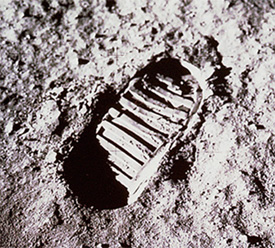First-Hand:Making Sure that the Lunar Lander was Correctly Tested

Submitted by Robert Catenaro
I worked 9 years for the defense contractor Sperry Gyroscope, and they had been steadily losing contracts. The future did not look bright for this company. Knowing that jobs in the defense industry were not secure, I knew it was time to find another employer. In 1962, Grumman (who was located on Long Island, and was in my commuting distance) won a space flight contract to provide the space vehicle which would deliver our astronauts to the moon and safely return them back to Earth. This space vehicle was called the Lunar Module (abbreviated as LM). It was called module because the LM was connected to the Command Module (CM). The two modules would take the journey to the Moon together and get into a lunar orbit together. The LM, holding 2 astronauts, would then separate from the CM to land on the lunar surface. One astronaut would stay in the CM in a lunar orbit. For the return, when their mission duties were complete, the LM would use its rocket to return with both astronauts to the CM. The CM then would safely return all 3 astronauts to Earth. When I applied for a position at Grumman Aerospace Corporation, I had a good resume showing my work at Sperry Gyroscope. Grumman needed many experienced engineers for this amazing undertaking, so it was no surprise that I was hired, and I was happy with that. The future proved that I was correct about Sperry Gyroscope and they shrunk to a minimal size corporation on Long Island.
I was hired at Grumman on Feb. 4, 1963. I was starting a new job with a recently born, 4 month old son, Daniel (Born Sept. 13, 1992) and a young 4 year old daughter, Barbara (born May 26, 1958). I think back and wonder why I wasn’t nervous about that situation. I think that when you run into life situations you decide what the best moves would be, and you go forge ahead without dwelling on the bad consequences that could happen. And that is what I did.
While working on the Apollo Project at Grumman, I came across a situation which concerned me about the way that the LM was being tested. There was a test group who was doing the testing of the LM. They were doing the tests without determining if these tests were thoroughly checking the LM, and not determining if the LM’s subsystems and as an overall system met the design requirements. In a test you must specify pass or fail boundaries, and the test group was not doing that. There were no limits on the values of the outputs. Almost any output would do. I believed that with the proper testing, it would give us more confidence that the mission would be successfully completed. Prior to this I had been working on the LM Guidance, Navigation and Control System (GNC), and I could see that that the testing going on was incomplete, and there was no basis for determining the expected outputs during the tests. To correct this situation I started with the GNC system, since it was the system that I was most familiar with. I went through each GNC subsystem specification and determined what inputs and outputs were needed to test each subsystem. Each specification defined not only the inputs and expected outputs, but also the allowable variation from the expected output. So in the case of the LM testing, the test group needed to be told what test to do and also how wide the tests outputs would be allowed to vary. If tests showed that the outputs deviated from the expected outputs by a greater amount than expected, then the system and subsystems were not meeting their requirements, indicating that there is something wrong and this system may not be ready to perform a successful mission. To correct this situation I wrote a memo describing the tests which had to be performed on the GNC subsystem. I specified what the inputs needed to be (in this case voltages) and what the outputs needed to be (I also specified allowable maximum and minimum output values). If measurements showed that the limit values were exceeded, then it was necessary to fail the system and determine and fix what was not performing correctly. The test group welcomed my memo because they now knew precisely what they had to test and what the allowable test output readings needed to be. Now that the value of my work was understood, it was clear that there were many other subsystems of the LM which needed this same treatment. Because management recognized this I got some help from engineers who were assigned to help me. I assigned the engineers to the subsystems that they were to work on. I showed them the approach I took and asked them to follow the system that I set up and asked them to produce a memo for each of the LM subsystems and groups of subsystems. The system test group followed each of the memos and set up their testing using these memos as a basis. This encouraged me to feel that the LM would be thoroughly tested, and that this would support the accomplishment of a successful mission. It is true that many thousands of engineers contributed to this successful manned lunar landing, I am proud that as one engineer, I was able to make a contribution.
Back to Human Space Travel Primary Sources